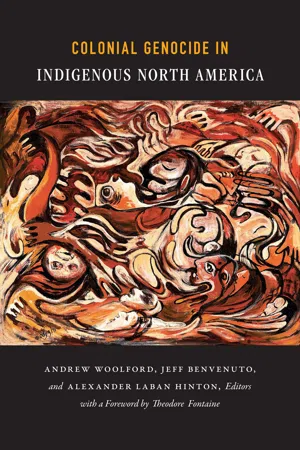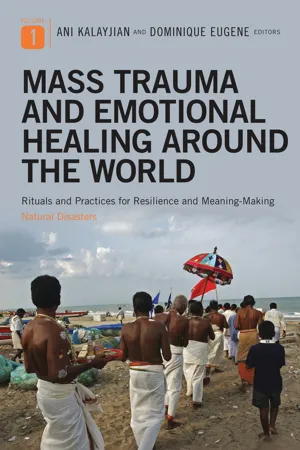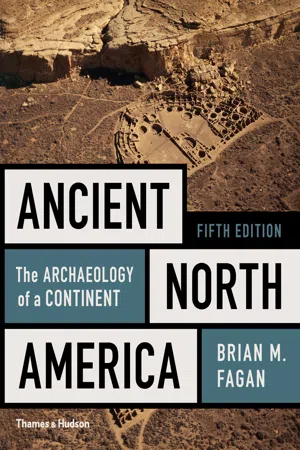History
Destruction of Native American Societies
The destruction of Native American societies refers to the devastating impact of European colonization on the indigenous peoples of the Americas. This included forced displacement, disease, warfare, and cultural suppression, leading to the decimation of native populations and the erosion of traditional ways of life. The consequences of this destruction continue to be felt in contemporary society.
Written by Perlego with AI-assistance
Related key terms
1 of 5
5 Key excerpts on "Destruction of Native American Societies"
- eBook - ePub
Genocide of Indigenous Peoples
A Critical Bibliographic Review
- Robert Hitchcock(Author)
- 2017(Publication Date)
- Taylor & Francis(Publisher)
intent to destroy a targeted group in whole or in part. This consideration greatly complicates the issue.The demographic collapse which Euro-American contact precipitated and perpetuated in Native America spans centuries and involves no less than eight colonial or federal governments, and thousands of distinct indigenous empires, cultures, and confederacies. How does one parse out the overall demographic decline of Native America as a whole into the appropriately specific geographic and chronologic terms? Furthermore, in ascertaining the commission of genocide, taking into consideration the issue of intent, how can such monumental numbers be properly assigned to the intent of innumerable separate and distinct Euro-American – Native American relationships? To label North America’s indigenous populations in such monolithic terms is more than problematic. To generalize about the actions and reactions of all officials at the federal, regional and local levels vis-à-vis their treatment of all Native American groups is equally problematic. To attempt to extrapolate from one case where there was clear genocidal intent to all other cases – across centuries and historical contexts – is to rely on inherently faulty methodological processes.One way to avoid unfairly extrapolating hemispheric or continental conclusions from regional histories is to refocus the scope of such research. While it is possible that a large composite of isolated events may speak to the existence of broader general trends, those more narrowly focused regional histories must be better understood before such conclusions can be fully supported. The concept of genocide in Native American history must first be analyzed in the micro, rather than macro scale. Once the sundry remote histories of possible genocide in Native North America are better documented and interpreted, and boast a more exhaustive historiography, broader generalized study of genocide in North America as a whole will be more productive, balanced, and substantive. - Alexander Laban Hinton, Andrew Woolford, Jeff Benvenuto, Alexander Laban Hinton, Andrew Woolford, Jeff Benvenuto(Authors)
- 2014(Publication Date)
- Duke University Press Books(Publisher)
(Indeed Rensink [2009] has drawn on the complex historical record to complicate the question of genocide even with reference to prototypical colonial massacres such as at Sand Creek.) Warfare by allied Natives and Europeans against other Natives and/or Eu-ropeans was an additional pattern, as was true of the French and Indian War during the mid-eighteenth century. Ethridge (this volume) illustrated still another pattern in which English traders centered in Carolina enlisted and equipped nearby Indigenous peoples to raid and enslave other Indige-nous peoples deep inside the southern colonial “shatter zone” (i.e., a region of “widespread internecine warfare resulting in dislocations, migrations, amalgamations, and, in some cases, extinctions of Native peoples”). Accord-ing to Ethridge, this expression of European commercial interests—fueled by English orchestration of the Indian slave trade primarily to the West Indies—was responsible for the demise of the mound-building chiefdoms of this region and the resultant rise of new remnant peoples such as the Choctaw, Cherokee, and Chickasaw. A final pattern involved catastrophic disruptions to Indigenous ways of life resulting from contact that were not necessarily intended or attended by colonizing Europeans. For illustrative purposes, consider briefly the historical context of one region of Native North America, namely, the high northern Plains during the nineteenth century. My own people, the Gros Ventre, were genocide and trauma in native north america 283 very significantly affected by colonial disruptions in what later became Al-berta, Saskatchewan, and Montana during the 1800s (Flannery 1953; Fowler 1987; Gone 2014). During this period our population catastrophically de-clined from perhaps three thousand individuals to 595 in total.- eBook - ePub
Destroying to Replace
Settler Genocides of Indigenous Peoples
- Mohamed Adhikari, Alfred J. Andrea(Authors)
- 2022(Publication Date)
- Hackett Publishing Company, Inc.(Publisher)
Despite its principal role in the genocide, there is one sense in which the army was less exterminatory in its dealings with Indians compared to vigilante gangs and militias. The army took more prisoners and was more concerned with deporting them to reservations with the help of Department of Indian Affairs officials. Life on the reservations, however, proved to be so lethal that it can justifiably be regarded as part of a broader pattern of genocidal destruction of Native American society. Militias and vigilantes were more murderous and thorough in their work of physical destruction, usually preferring not to be hampered by prisoners, even though they may have had some value as forced laborers.{95} Indirect Killing and Nonlethal Ways of Social DestructionBecause of the intensity of violence on the California frontier and most of the bloodletting being concentrated in little more than one and a half decades—from the time the gold rush started in earnest in early 1849 and sustained killing died down by early 1865—the focus thus far has largely been on direct killing. It goes without saying that large numbers of Native American people also died in a variety of other ways immediately related to settler conquest. Neither can it be denied that nonlethal means of social destruction contributed greatly to the genocide.Thousands of Native Americans perished of starvation and exposure that came with being displaced from their land. Groves of oak trees were leveled or put out of bounds; game animals were hunted to near extinction; edible plants and grass seeds were destroyed by stock; Indigenous peoples were denied access to fishing grounds; and sources of water were often polluted or placed off-limits. Not only did settler economic activity destroy food sources, consume environmental resources, and disrupt the natural rhythms on which Native Americans depended, but settler insurgents were generally diligent when it came to wrecking their food stores, shelters, and vital equipment, such as canoes, nets, and hunting gear. Displaced people were left with little option but to enter the employ of colonists, frequently as virtual serfs or slaves, or move to secluded highland areas where food was scarce, the climate inhospitable; and yet they were not safe from attack by settler posses intent on hunting them down. - eBook - PDF
Mass Trauma and Emotional Healing around the World
Rituals and Practices for Resilience and Meaning-Making [2 volumes]
- Ani Kalayjian, Dominique Eugene, Ani Kalayjian, Dominique Eugene(Authors)
- 2009(Publication Date)
- Praeger(Publisher)
Similar programs would fit well in other regions to promote understanding of the trauma experienced by other Native populations. CONCLUSION Clearly, Native Americans have experienced extensive trauma as part of the colonization process, and their colonization experiences continue under their current status as domestic dependent nations subject to federal oversight. The legacy of terror initiated by massacres, forced removals, and other byproducts of colonization leaves many Native people with psy- chological symptoms, struggles with alcohol, and doubt in their selves and their cultures (Faimon 2004). It is important to recognize that the traumatic affects of colonization are ongoing and not just a historical artifact. Native people are still subject to removal from their territories, as, for example, the removal of Navajo and Hopi people from Big Mountain from the 1970s into the early 1990s (Ve- nables 2004). Ongoing conflicts with the federal government and lack of success in the U.S. legal system leave Native people little reason to believe that their rights will be respected. It is also important to note that Ameri- cans cannot get away with believing that injustice and oppression happen only in other places. Indeed, the Kinzua example illustrates that disenfran- chisement and oppression happen within U.S. borders in contemporary times. The traumatic impact of such events cannot be denied or ignored. The fact that much of the trauma experienced by Native Americans is man- made, large-scale, and ongoing poses substantial challenges for healing. In spite of these challenges, many Native American communities have developed effective mechanisms for addressing trauma. Most notably, it is important for the truth about traumatic events, both historical and contemporary, to be acknowledged. Many annual community events of remembrance serve the function of both retelling events from a Native per- spective and validating their significance. - eBook - PDF
Ancient North America
The Archaeology of a Continent
- (Author)
- 2020(Publication Date)
- Thames and Hudson Ltd(Publisher)
It also allows us to study culture change in both European and Native American society over the centuries. • The impact of exotic, infectious diseases on Native American societies was disastrous and led to significant depopulation and other consequences, including the loss of traditional knowledge. 333 Colonists, Borderlands, and Missionaries The Spanish Borderlands: 1539 and Later 334 THE CREEK AND THE DEERSKIN TRADE 338 Jamestown: 1607 339 Martin’s Hundred: 1618 to 1622 342 HISTORICAL ARCHAEOLOGY AND THE CASE OF THE MISSING HOMEOWNER 344 La Florida 344 Spanish Missions 346 MISSION NUESTRA SEÑORA DE LA SOLEDAD 348 Summary 349 CHAPTER 15 334 PART FIVE | CONSEQUENCES OF CONTACT The seventeenth century saw European colonization in full swing. To the north, the English had founded Jamestown on the Chesapeake in 1607, which soon became an important trading center with tentacles that stretched far into the Southeast and regularly seized Native Americans for the slave trade. The Mayflower anchored off Plymouth in New England in 1620. Forty-four years later, in 1664, English colonists took New York, ending over fifty years of Dutch influence over fur trading in the Northeast. Even further north, the French had settled along the St. Lawrence, where they dominated fur-trading activity in that region. Their fur traders and explorers had spread throughout the Great Lakes during the seventeenth century, while Marquette and Joliet descended the Mississippi Valley in 1673. La Salle followed in their footsteps and even tried to colonize the Texas coast. By 1700 the peoples of the Eastern Woodlands were surrounded by European visitors. Dutch, English, French, and Spanish—each group had different, competing interests that exerted severe pressure on Native American groups often hundreds of miles away from actual direct contact with the foreigners (Figure 15.1).
Index pages curate the most relevant extracts from our library of academic textbooks. They’ve been created using an in-house natural language model (NLM), each adding context and meaning to key research topics.




